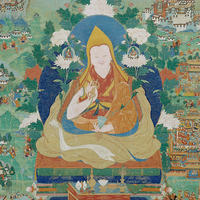
The Fifth Dalai Lama
The Fifth Dalai Lama, Ngawang Losang Gyatso (Ngag-dbang blo-bzang rgya-mtsho, 1617-1682), stands as a colossus in Tibetan history, embodying the union of spiritual and temporal authority. Known for his profound spiritual insight and adept political acumen, he founded the Ganden Phodrang (dGa'-ldan pho-brang) government, which established the Dalai Lamas as both spiritual and political leaders of Tibet. His era marked a significant turning point, leading to the centralization of power and the flourishing of Tibetan culture and Buddhism under his leadership.
Born on July 30, 1617 as Kunga Migyur (Kun-dga mi-'gyur) in the Chonggye Valley (‘Phyongs-rgyas rdzong) of U (Dbus) to a noble family with ties to the Nyingma and Kagyu traditions, his early life was marked by auspicious signs, foretelling his future significance. At the age of five, he was recognized by Losang Chokyi Gyaltsen (Blo-bzang chos-kyi rgyal-mtshan) as the reincarnation of the Fourth Dalai Lama through a series of traditional tests, including visions at the sacred Oracle Lake, Lhamo Latso (Lha-mo bla-mtsho). Losang Chokyi Gyaltsen gave the young child the name Losang Gyatso and enthroned him at Drepung Monastery ('Bras-spungs dgon). When he took full ordination at the age of 21, Ngawang was added to his name. Later on, as the Fifth Dalai Lama, he would bestow upon Losang Chokyi Gyaltsen the title of “Panchen Lama” (Pan-chen bla-ma).
Educated at Drepung Monastery, one of Tibet's great centers of learning, he mastered Buddhist philosophy, tantra and sutra under the guidance of eminent teachers of the time. His scholarly works included commentaries on Buddhist texts written from the Gelug, Nyingma and Sakya points of view. His pure visions of dzogchen were compiled in Bearing the Seal of Secrecy (gSang-ba rgya-can). In all, he wrote 24 volumes’ worth of both scholarly and religious works on a variety of topics, including a history of Tibet.
The fragmented political landscape of Tibet, characterized by rivalries among different Buddhist schools and regional warlords, set the stage for the Fifth Dalai Lama’s rise to power. His alliance with Gushri Khan (1582-1655), the leader of the Khoshut Mongols, was instrumental in establishing the Ganden Phodrang as the governing authority of Tibet, effectively unifying the country under his rule. As head of state, he institutionalized Nechung as the State Oracle.
Futhermore, as the head of the Gelug (dGe-lugs) school, he implemented significant reforms in monastic discipline and administration, consolidating the school’s dominance in Tibetan Buddhism. His efforts to mediate conflicts among the various religious traditions helped to foster a more unified Tibetan Buddhist identity across the different provinces. The construction of the Potala Palace (Po-ta-la) in Lhasa, which he re-established as the capital of Tibet, is among the Fifth Dalai Lama's most enduring legacies, symbolizing the fusion of spiritual and temporal authority. His patronage of the arts spurred a renaissance in Tibetan culture, encompassing literature, painting, and architecture.
The Fifth Dalai Lama's diplomatic engagements, particularly with the Manchu Qing Dynasty of China and various Mongol tribes, also established Tibet as a significant player in regional politics. His historic visit to the Shunzhi Emperor in Beijing in 1652 underscored the importance of Sino-Tibetan relations and highlighted his role as both a spiritual leader and sovereign ruler.
The Fifth Dalai Lama passed away in 1682 at the age of 65, but this was kept secret by the Prime Minister, Desi Sangye Gyatso (sDe-srid sangs-rgyas rgya-mtsho, 1653-1705) until 1696, to ensure the completion of the Potala Palace and to prevent any of Tibet’s neighbors from taking advantage of the situation before the Sixth Dalai Lama could assume power.
The Great Fifth Dalai Lama, as he came to be known, left an indelible mark on the history of Tibet, shaping its religious, cultural, and political landscape in ways that resonate to this day. His legacy, embodied in the institutions he established and the teachings he imparted, continues to influence not only Tibetan Buddhism but also the global understanding of Buddhism’s role in the world today.